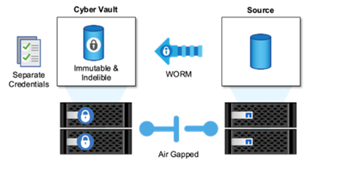Air-gapped WORM protection with cyber vaulting in ONTAP
 Suggest changes
Suggest changes


NetApp's approach to a cyber vault is a purpose-built reference architecture for a logically air-gapped cyber vault. This approach takes advantage of security hardening and compliance technologies, such as SnapLock, to allow for immutable and indelible snapshots.
Cyber vaulting with SnapLock Compliance and a logical air gap
A growing trend is for attackers to destroy the backup copies and, in some cases, even encrypt them. That is why many in the cybersecurity industry recommend using air gap backups as part of an overall cyber resiliency strategy.
The problem is that traditional air gaps (tape and offline media) can significantly increase restoration time, thus increasing downtime and the overall associated costs. Even a more modern approach to an air-gap solution can prove problematic. For example, if the backup vault is temporarily opened to receive new backup copies and then disconnects and closes its network connection to primary data to once again be "air gapped", an attacker could take advantage of the temporary opening. During the time the connection is online, an attacker could strike to compromise or destroy the data. This type of configuration also generally adds unwanted complexity. A logical air gap is an excellent substitute for a traditional or modern air gap because it has the same security protection principles while keeping the backup online. With NetApp, you can solve the complexity of tape or disk air gapping with logical air gapping, which can be achieved with immutable snapshots and NetApp SnapLock Compliance.

NetApp released the SnapLock feature more than 10 years ago to address the requirements of data compliance, such as the Health Insurance Portability and Accountability Act (HIPAA), Sarbanes-Oxley, and other regulatory data rules. You can also vault primary snapshots to SnapLock volumes so that the copies can be committed to WORM, preventing deletion. There are two SnapLock license versions: SnapLock Compliance and SnapLock Enterprise. For ransomware protection, NetApp recommends SnapLock Compliance because you can set a specific retention period during which snapshots are locked and cannot be deleted, even by ONTAP administrators or NetApp Support.
Tamperproof snapshots
While leveraging SnapLock Compliance as a logical air gap provides the ultimate protection in preventing attackers from deleting your backup copies, it does require you to move the snapshots using SnapVault to a secondary SnapLock-enabled volume. As a result, many customers deploy this configuration on secondary storage across the network. This can lead to longer restoration times versus restoring a primary volume Snapshot on primary storage.
Beginning in ONTAP 9.12.1, tamperproof snapshots provide near SnapLock Compliance level protection for your snapshots on primary storage and in primary volumes. There is no need to vault the snapshot using SnapVault to a secondary SnapLocked volume. Tamperproof snapshots use SnapLock technology to prevent the primary snapshot from being deleted, even by a full ONTAP administrator using the same SnapLock retention expiration period. This allows for quicker restore times and the ability for a FlexClone volume to be backed up by a tamperproof, protected snapshot, something you cannot do with a traditional SnapLock Compliance vaulted snapshot.
The major difference between SnapLock Compliance and tamperproof snapshots is that SnapLock Compliance does not allow the ONTAP array to be initialized and wiped if SnapLock Compliance volumes exist with vaulted snapshots that have not yet reached their expiration date. To make snapshots tamperproof, a SnapLock Compliance license is required.



 Release notes
Release notes
